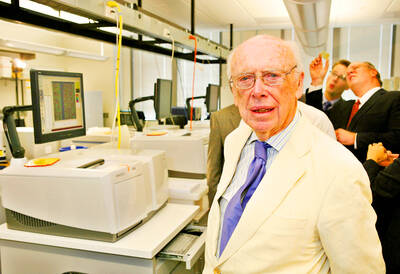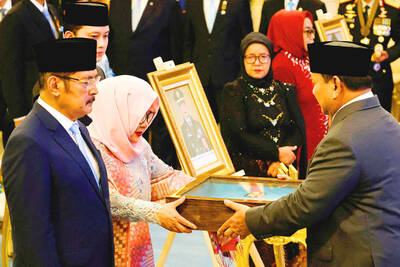The first US prosecution of a pharmaceutical company chief executive tied to opioid overdoses began yesterday as Insys Therapeutics Inc CEO John Kapoor went on trial. The fallout could jolt an industry facing steep penalties for its own role in the crisis.
Kapoor, 75, is accused of masterminding illegal marketing tactics that contributed to an epidemic of addiction and death. A onetime billionaire who rose from modest means in India, he is on trial for using speakers’ fees, dinners and cash to lure doctors into prescribing a highly addictive opioid painkiller meant solely for cancer patients.
The case is being heard in Boston, Massachusetts, but the verdict could echo in the boardrooms of the US’ pharmaceutical companies. More than 1,500 US local governments have sued opioid makers and distributors to recoup the billions of US dollars spent fighting the crisis. The clash could serve as a test drive for how jurors weigh claims of industry wrongdoing.
“It’s a real advantage for the local governments’ lawyers to get jury feedback on the Insys marketing evidence,” said Richard Ausness, an expert on mass tort law at the University of Kentucky College of Law. “It will help them build their conspiracy cases against all the companies involved in the opioid litigation.”
A conviction could turn Kapoor into the face of the opioid crisis.
The first person in his family to attend college, he became a healthcare entrepreneur after earning a doctorate in medicinal chemistry at the University of Buffalo in 1972. He worked as a drug plant manager and later became chief executive of a hospital products company.
After forming a venture capital firm that invested in healthcare companies, he merged closely-held Insys with NeoPharm in 2010 to get access to technology to develop pain drugs for cancer patients.
He remains Insys’ majority shareholder, controlling about 60 percent of its shares, company filings showed.
The shares have fallen by about one-third since Kapoor’s October 2017 indictment.
A conviction on federal fraud, racketeering and kickback charges could send Kapoor and four other former Insys managers to prison for as long as 25 years.
They are accused of bribing doctors to prescribe Subsys, an opioid painkiller approved in 2012 for late-stage cancer patients.
Prosecutors have said that Kapoor oversaw a scheme in which doctors got sham speaker’s fees in return for issuing more prescriptions, and that subordinates lied to insurers about the type of patients receiving the fentanyl-based drug.
Doctors were allegedly seduced with jobs for relatives, lavish meals and, in one case, a US$1,000 private champagne-room session at a strip club.
As the bribes generated Subsys sales, Kapoor pumped more money into speakers’ fees, with spending jumping to US$10.5 million in 2014 from US$550,000 two years earlier, prosecutors said.
Also on trial is Sunrise Lee, a former stripper who, as an Insys sales manager, enticed physicians into writing more prescriptions, prosecutors said. “
“Doctors really enjoyed spending time with her and found Sunrise to be a great listener,” Insys manager Alec Burlakoff told colleagues, according to court filings.
The other defendants are former Insys vice president Michael Gurry, former national sales director Richard Simon and former regional sales director Joseph Rowan.
The accused have denied wrongdoing.
Former Insys chief executive Michael Babich pleaded guilty this month and agreed to cooperate in a bid for leniency.

James Watson — the Nobel laureate co-credited with the pivotal discovery of DNA’s double-helix structure, but whose career was later tainted by his repeated racist remarks — has died, his former lab said on Friday. He was 97. The eminent biologist died on Thursday in hospice care on Long Island in New York, announced the Cold Spring Harbor Laboratory, where he was based for much of his career. Watson became among the 20th century’s most storied scientists for his 1953 breakthrough discovery of the double helix with researcher partner Francis Crick. Along with Crick and Maurice Wilkins, he shared the

OUTRAGE: The former strongman was accused of corruption and responsibility for the killings of hundreds of thousands of political opponents during his time in office Indonesia yesterday awarded the title of national hero to late president Suharto, provoking outrage from rights groups who said the move was an attempt to whitewash decades of human rights abuses and corruption that took place during his 32 years in power. Suharto was a US ally during the Cold War who presided over decades of authoritarian rule, during which up to 1 million political opponents were killed, until he was toppled by protests in 1998. He was one of 10 people recognized by Indonesian President Prabowo Subianto in a televised ceremony held at the presidential palace in Jakarta to mark National

US President Donald Trump handed Hungarian Prime Minister Viktor Orban a one-year exemption from sanctions for buying Russian oil and gas after the close right-wing allies held a chummy White House meeting on Friday. Trump slapped sanctions on Moscow’s two largest oil companies last month after losing patience with Russian President Vladimir Putin over his refusal to end the nearly four-year-old invasion of Ukraine. However, while Trump has pushed other European countries to stop buying oil that he says funds Moscow’s war machine, Orban used his first trip to the White House since Trump’s return to power to push for

LANDMARK: After first meeting Trump in Riyadh in May, al-Sharaa’s visit to the White House today would be the first by a Syrian leader since the country’s independence Syrian President Ahmed al-Sharaa arrived in the US on Saturday for a landmark official visit, his country’s state news agency SANA reported, a day after Washington removed him from a terrorism blacklist. Sharaa, whose rebel forces ousted long-time former Syrian president Bashar al-Assad late last year, is due to meet US President Donald Trump at the White House today. It is the first such visit by a Syrian president since the country’s independence in 1946, according to analysts. The interim leader met Trump for the first time in Riyadh during the US president’s regional tour in May. US envoy to Syria Tom Barrack earlier